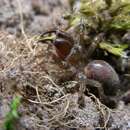en
names in breadcrumbs


The mygalomorph spider family Atypidae (purseweb spiders) includes 49 species in 3 genera (Platkin 2013). Purseweb spiders are found in the Holarctic (Nearctic + Palearctic regions) as well as in the Old World tropics. In North America north of Mexico, purseweb spiders are found only in the eastern half of the United States and in southern Ontario, Canada. Eight species occur in this region, seven of them in the genus Sphodros and one in Atypus. (Coyle 2005)
Purseweb spiders buld a silken tube that is partly buried but extends above the ground. The exposed part of the tube is often attached to a tree trunk, rock, or other vertical surface. The surface of the tube is covered with bits of debris and soil, helping it blend in with its surroundings. The spider waits within the tube and when it senses vibrations from potential prey walking over the tube, the spider strikes through the tube wall with its very long fangs. After capture, a small temporary slit is cut in the tube and the prey is drawn in, after which the slit is quickly repaired. The spider thus lives almost its entire life hidden from view—and some females have been known to live for at least seven years. Only dispersing juveniles and adult males in search of mates are found out in the open.(Coyle 2005; Bradley 2013)
A striking morphological feature of purseweb spiders is their large, forward-projecting chelicerae. These are often two thirds as long as the carapace (the upper surface of the cephalothorax) and armed with long, heavy fangs. Although these large-fanged spiders appear quite fierce, especially when they rear up in a defensive posture, they are harmless to humans and will not bite unless provoked.(Bradley 2013)
More information on purseweb spiders can be found in Gertsch and Platnick (1980) and Coyle and Shear (1981).
Atypidae, also known as atypical tarantulas or purseweb spiders, is a spider family containing only three genera. They are accomplished ambush predators that spend most of their time in a sock-like, silken retreat on the ground from where they kill their prey.[1]
Sphodros and Atypus occur in North America, while Atypus and Calommata occur in Asia and Africa. Only Atypus species are found in Europe.[2] Atypus affinis, Atypus muralis, and Atypus piceus are the only mygalomorph spiders found in northwestern Europe.
Atypus builds a silken tube parallel to the surface of the ground. While up to 8 cm of the tube lie on the ground, about 20 cm are buried vertically. The spider rests at the bottom of the tube. When prey walks on the exposed part, the spider, alerted by the vibrations, stabs the prey through the silk, cuts the web and drags the prey inside to be eaten. Calommata species, instead of building a purse web, live in burrows.[3] Sphodros spp. usually prop their tubes against a tree trunk.
Atypical tarantulas have huge chelicerae for their size and relatively long spinnerets (although not as long as those found in diplurids). The males are sometimes brightly colored and wander around looking for females in their tubes. The females are reddish-brown or dark-colored.
During the breeding season for A. affinis, the male leaves his own burrow and goes in search of females. When he finds the burrow of a female, he tentatively taps on the wall of the purse web, and if the female is receptive, he ventures into the confines of the burrow. The two spiders mate and cohabit until the male dies, when the female eats him. The female makes an egg sac and hangs it in her burrow. The next summer, the eggs hatch, and the spring after that, the spiderlings leave their mother's burrow and wander off to find a suitable place to build a lair of their own.[1]
Southeast Asian Atypus species have a body length of 7 to 21 mm in females, and about 12 mm in males. Calommata spp. of this region grow from 23 to 30 mm in females, and only about 7 mm in males.[3]
As of April 2019, the World Spider Catalog accepts the following genera:[2]
Atypidae, also known as atypical tarantulas or purseweb spiders, is a spider family containing only three genera. They are accomplished ambush predators that spend most of their time in a sock-like, silken retreat on the ground from where they kill their prey.